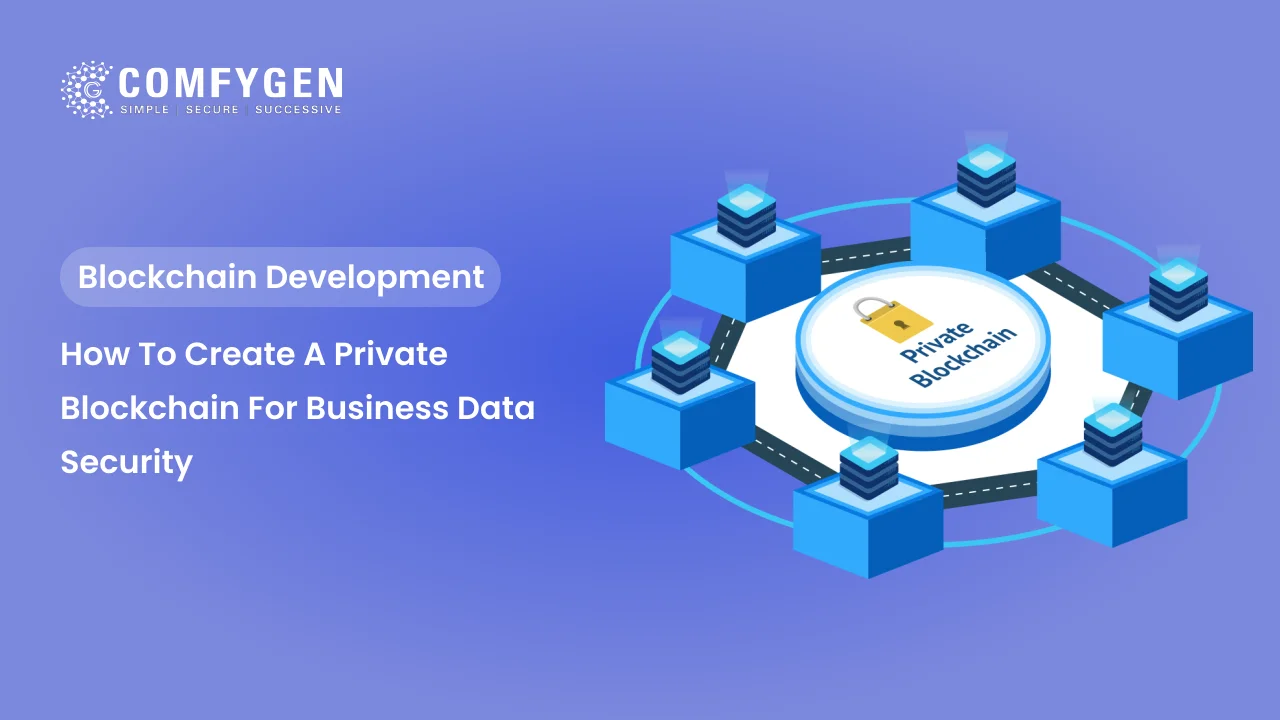Step 7: Test, Monitor, and Deploy
Ensure your solution is production-ready:
-
Use blockchain explorers for transaction tracking
-
Monitor system health with logging tools
-
Set up CI/CD pipelines for updates and patches
Mobile App Development
Web Development
Stack Development
Blockchain Development
Token Development
Other Development
Games
Game Development
Game API Development
Our Company

Excel in business growth with modern digital transformation. We are a top-tier web & mobile app development company that designs cutting-edge IT Solutions tailored to unique needs and conquers all market challenges. Our webs and apps propel toward streamlined operations and vast engagement empowering businesses across various industries.
6+ Year's Experience
250+ Project Delivered
100+ Total Happy Client
With growing concerns around data privacy and security, many businesses are now choosing private blockchain development as a safer alternative to traditional centralized systems. A private or permissioned blockchain allows only authorized users to access and share data, making it perfect for companies that need secure, compliant, and high-performance blockchain solutions.
In this guide, we’ll walk you through the step-by-step process of building a private blockchain using trusted platforms like Hyperledger Fabric and Quorum. You’ll also discover best practices for creating secure blockchain networks and smart contracts tailored for enterprise use.
A private blockchain is a type of permissioned blockchain network where access is restricted to selected participants. Only authorized users can view, write, or validate transactions. This setup ensures greater privacy, control, and data integrity, making it ideal for businesses that handle sensitive or regulated information. Private blockchains are commonly used in industries like finance, healthcare, supply chain, and government, where trust, compliance, and security are essential.
To build a secure and efficient private blockchain, it’s important to understand its essential components. These elements work together to ensure trust, control, and performance across the network:
Ledger – The ledger is a shared, tamper-proof record of all transactions. It ensures transparency and integrity while protecting sensitive data.
Public blockchains are open to anyone, allowing full transparency and participation. In contrast, private blockchains are permissioned networks designed specifically for internal operations. Only approved users can access or validate data, making them ideal for blockchain in business environments where security, compliance, and control are top priorities.
blockchain development company offers several powerful benefits tailored to enterprise needs. It ensures stronger data protection, operational transparency, and compliance readiness—making it a smart investment for modern organizations.
Before beginning your private blockchain development journey, it’s important to align your strategy with your business needs and technical environment. A well-planned approach helps ensure long-term success and scalability.
Clearly define your blockchain for business use case—whether it’s data privacy, auditability, workflow automation, or secure record tracking.
Assess your regulatory and compliance requirements, such as GDPR, HIPAA, or SOC 2, based on your industry.
Choose the right enterprise blockchain platform, like Hyperledger Fabric, Quorum, or R3 Corda, to match your goals.
Identify how your private blockchain network will integrate with existing ERP, CRM, or cloud systems.
Consider custom blockchain development when off-the-shelf solutions don’t meet your security, logic, or scalability needs.
Thoughtfully addressing these points will help you build a robust, compliant, and future-ready private blockchain solution tailored to your enterprise.
Building a private blockchain development project requires a structured approach to ensure security, scalability, and enterprise-grade performance. Here’s a simplified process to guide you:
Your selected blockchain framework for business will shape your architecture, security model, and governance. Popular choices include:
Hyperledger Fabric – Modular and permissioned, ideal for enterprise blockchain platforms.
Quorum – Ethereum-based with privacy enhancements for internal networks.
R3 Corda – Tailored for financial systems and secure data exchange.
Multichain – Lightweight, flexible, and great for custom blockchain development.
In permissioned blockchain development, consensus protocols ensure trust without mining:
Raft – Leader-based, simple, and fault-tolerant.
PBFT (Practical Byzantine Fault Tolerance) – Strong security in unpredictable environments.
IBFT (Istanbul BFT) – Suitable for highly secure enterprise use cases.
Structure your private blockchain network to meet enterprise needs:
Define number of nodes across departments or partners.
Assign node roles (validator, client, admin).
Set encryption and visibility rules for secure data flow.
Use role-based blockchain permissions to safeguard data:
Multi-factor authentication
LDAP or OAuth integration
Blockchain-native identity management solutions
Automate your enterprise workflows securely:
Define transaction rules and workflows
Develop and deploy smart contracts (or chaincode for Hyperledger)
Conduct thorough audits and testing for reliability
Bridge your blockchain with internal or third-party systems:
Build REST APIs and SDKs for integration
Create dApps, dashboards, and user portals
Support seamless user experience across devices
Choosing the right private blockchain platform is crucial to ensure scalability, security, and compliance. Below are the leading platforms used in enterprise blockchain development:
| Platform | Key Features |
| Hyperledger Fabric | Modular design, role-based access control (RBAC), and pluggable consensus |
| Quorum | Ethereum-compatible, supports private transactions and network permissions |
| R3 Corda | Built for financial institutions with secure, point-to-point data sharing |
| Multichain | Lightweight and ideal for custom blockchain development with fast setup |
To protect sensitive business data, your private blockchain development must prioritize enterprise-grade security. Implement these best practices:
End-to-end encryption (SSL/TLS, TLS tunneling, zero-knowledge proofs) for data privacy
Secure key management to block unauthorized access
Smart access controls based on identity roles and contracts
Audit-ready secure smart contract development with vulnerability checks
These practices build a foundation for blockchain for data security and compliance.
| Challenge | Practical Solution |
| Scalability | Use sidechains, sharding, or off-chain transactions for faster processing |
| Interoperability | Integrate bridges, APIs, and multi-chain blockchain development tools |
| Enterprise Onboarding | Provide user-friendly dashboards, guided onboarding flows, and training materials |
Private blockchain development is transforming the way industries manage, secure, and share sensitive information. With permissioned access, cryptographic security, and built-in audit trails, private blockchains offer a trusted solution for sectors where data security, compliance, and operational transparency are critical.
Healthcare providers are using private blockchain architecture to share patient records securely across hospitals, labs, and insurers. With blockchain for compliance, systems can meet HIPAA and GDPR standards, ensuring patient consent, data immutability, and secure identity management.
Use Case: Encrypted medical histories shared only with authorized caregivers and regulators in real time.
In financial services, permissioned blockchain development ensures that audit logs and transaction data are tamper-proof and instantly accessible to approved parties. This allows for accurate regulatory reporting, fraud detection, and secure interbank transfers.
Use Case: A consortium of banks using private blockchain to reconcile real-time settlements with transparent oversight.
Manufacturers and distributors use private blockchain architecture to track every step of a product’s lifecycle—from raw material sourcing to retail delivery. This combats counterfeiting and improves trust among partners and regulators.
Use Case: A global food company uses private blockchain to trace ingredients, verify certifications, and respond instantly to recalls.
Private blockchain development is helping insurers automate claims processing and reduce fraud by offering transparent, immutable records of policies, claims, and payouts. With smart contracts, rules can be enforced automatically while ensuring full regulatory compliance.
Use Case: An insurance firm uses permissioned blockchain development to automate auto-claim approvals and manage reinsurance data securely.
Educational institutions use private blockchain architecture to issue tamper-proof certificates, verify academic records, and manage student data across institutions. It enhances trust in credentials and streamlines background checks.
Use Case: A university network builds a private blockchain platform to allow employers and agencies to instantly verify student degrees and transcripts.
Governments use permissioned blockchain to ensure transparency in public records, e-governance, and citizen data management—while maintaining full control and regulatory oversight.
Use Case: A municipal agency implements a private blockchain solution for land records, ensuring transparent ownership transfers and reducing disputes.
Manufacturers are deploying private blockchain development to track components, ensure production quality, and maintain compliance across multi-tier supply chains. This brings visibility and accountability from factory to delivery.
Use Case: An electronics firm uses blockchain for business to record component history and detect counterfeit parts in its production lines.
Telecom providers use blockchain networks for managing roaming agreements, secure billing, and preventing identity fraud across international carriers. It enhances trust and streamlines inter-operator coordination.
Use Case: A telecom consortium uses a private blockchain platform to reconcile cross-border usage data and automate roaming fee settlements.
Building a private blockchain isn’t just a tech upgrade—it’s a strategic investment in enterprise security, transparency, and long-term innovation. With advanced platforms like Hyperledger Fabric, Quorum, and R3 Corda, businesses can unlock secure data sharing, automate workflows with smart contracts, and meet complex compliance demands with confidence.
At Comfygen Technologies, we specialize in helping enterprises design and deploy custom private blockchain solutions that are scalable, secure, and built for your specific industry needs. Whether you’re in healthcare, finance, supply chain, or government, our expert team guides you from strategy to launch—ensuring seamless integration, role-based access control, and future-ready architecture.
Choose Comfygen Technologies as your trusted partner in private blockchain development and start building a more secure, transparent, and efficient digital future today.

Mr. Saddam Husen, CTO at Comfygen, is a renowned Blockchain expert and IT consultant with extensive experience in blockchain development, crypto wallets, DeFi, ICOs, and smart contracts. Passionate about digital transformation, he helps businesses harness blockchain technology’s potential, driving innovation and enhancing IT infrastructure for global success.

Blockchain technology evolution is transforming every industry with its secure parameters, transparency, and interoperability. Additionally, the tokenization market is growing from $2-3…